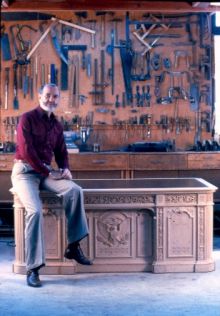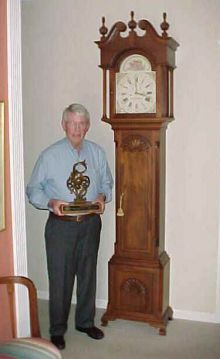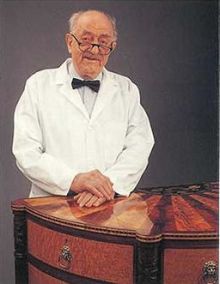Cartouche Recipients
2003: Gene Landon (1934 - 2011)
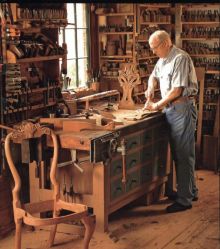
Gene owned and operated Landon Chemical Inc. He also repaired, restored and reproduced 18th-century furniture. During his career he taught 18th-century furniture making at Olde Mill Cabinet Shoppe in York, Pa. Gene was a founding member of the Society of American Period Furniture Makers. The Cartouche Award is based on the cartouche which crowns a Philadelphia tall case clock he built.
Pieces of furniture Gene made or restored are displayed in many museums across the United States, as well as in the White House. A life size eagle he carved out of the last living Liberty Tree located at St. John's College, Annapolis Md., is displayed at the Constitution Center, along with a copy of the Rising Sun Chair that he made.
As many period furniture makers did, Gene gained a lot of his knowledge from restoring antiques. By taking apart original pieces he could see how they were made, and examine the tool marks left on the piece. His goal was to try and replicate an original as closely as possible.
Inspiration: Gene Landon and Seven Hearths
E.E.L.: The Tool Collection of Gene Landon
2002: Robert Whitley
Robert's father was an artist and an antique collector. From 1948 to 2011, Robert restored antique furniture for major antique dealers, private collectors, museums, state and government institutions.
His works are exhibited in the permanent collections of the National Museum of Fine Arts, the Smithonian, the Philadelphia Museum of Art, Independence Hall, and many other museums and private collections.
Major Awards:
- National Merit Award, Museum of Contemporary Crafts, 1966
- Craft Multiples Award, Renwick Gallery, Smithsonian Institution, 1975
- Handmade Furniture Exhibit Award, American Craft Museum, 1979-80
- Individual Grant, National Endowment of the Arts, Washington D.C., 1980
- First Place Award of Excellence, The American Woodworker Magazine, 1996
- Bucks County Arts Lifetime Achievement Award, Central Bucks Chamber of Commerce, 2002
Major Commissions:
- John Fitzgerald Kennedy Library, Boston, Massachusetts
- Independence Hall, Philadelphia, PA
- Dolly Madison House
- Second National Bank of the United States
- Graff House
- Franklin Court
- City Tavern
- Carpenters' Hall
- George Washington's Headquarters, Morristown, New Jersey.
- Bent's Old Fort, La Junta, Colorado
- Valley Forge Historical Park
- Derby House, Salem, Massachusetts
- Ebenezer Maxwell Mansion Philadelphia, PA
- The Athenaeum, Philadelphia, PA
- St. Peter's Episcopal Church
Private Commisions:
- Philladelphia Queen Anne Arm Chair, circa 1745
- Chippendale Scro11-Top Highboy, Philadelphia, circa 1745
2001: John McAlister
|
|
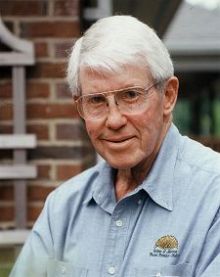 |
John worked wood as an amateur for over 35 years, most of it satisfying his passion for building 18th century American period furniture. He was a self-taught, consummate craftsperson whose introduction to furniture making was Marlow's Fine Furniture for the Amateur Cabinetmaker. John made all the pieces in the book.
In fact, no period piece had ever intimidated John, but that is to be expected from this former fighter pilot who flew P-51's during WW II. His home was filled with his work, including his masterpiece Goddard-Townsend secretary. This piece was featured on the back cover of the April 1998 Fine Woodworking.
Like many period furniture makers who started before woodworking magazines appeared, John visited countless museums inspecting and measuring pieces of furniture that he later recreated in his basement workshop.
Furniture in the SAPFM Gallery
2000: Harold Ionson (1920 - 2001)
Harold Ionson was the first recipient of the Cartouche Award for lifetime achievement in period furniture from the Society of American Period Furniture Makers. He apprenticed as a cabinetmaker in the Boston shops in the 1930's, was a union carpenter, served in World War II, and then became a patternmaker until his retirement.
After retiring, he became the consumate recreator of John and Thomas Seymour pieces. Harold decided to build the 'Derby' commode, probably the most lavish piece ever built by them.
The original commode was purchased by Elizabeth Derby West in 1809. Although credited to Thomas Seymour, the talents of James Cogswell, Thomas Wightman, and John Penniman were instrumental in its construction.
Because of the time spent on all of the jigs and fixtures needed for construction, Harold built nine Derby commodes over a period of twelve years. (He called them 'recreations' because they were not intended to be exact copies.)
His wife Martha used to make bandings with him in the shop.
One of the recreations, completed around 2001, went on auction August 10, 2014. It sold for $20,910.
Harold Ionson: The Master Cabinetmaker's 'Derby' Demi-Lune Commodes. American Period Furniture January 2001, Volume 1Federal Masterpiece Re-Creation . Antiques & Fine Arts.

